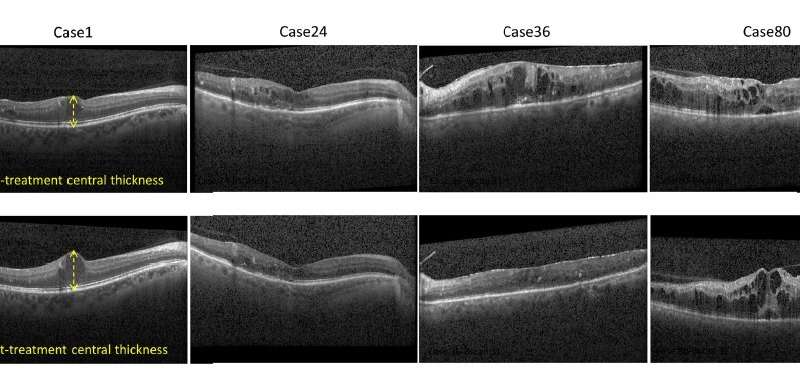New Artificial Intelligence Platform Can Indicate Treatment Outcome For Diabetes-Related Vision Loss
Source: Thailand Medical News Jan 29, 2020 5 years, 11 months, 1 week, 3 days, 13 hours, 44 minutes ago
A novel protocol that uses
artificial intelligence (
AI) to analyze retinal images could one day help doctors select the best treatment for patients with
vision loss from
diabetic macular edema. This
diabetes complication is a major cause of
vision loss among working-age adults.
Typically,
anti-vascular endothelial growth factor (
anti-VEGF) agents are widely used as the first line of therapy for
diabetic macular edema, but they don't work for everyone. There's a need to identify who would benefit from the therapy because it requires multiple injections that are costly and burdensome for both patients and physicians.
 Researchers developed a new algorithm that can use a single OCT scan to predict whether
Researchers developed a new algorithm that can use a single OCT scan to predict whether
a patient with diabetic macular edema is likely to respond to anti-VEGF treatments. They
tested it on pretreatment OCT images (top row) and used post-treatment OCT images
(bottom row) to track response to treatment. Case 24 and 36 responded to treatment.
Credit: Sina Farsiu, Duke University
Research team leader Dr Sina Farsiu from Duke University told
Thailand Medical News, "We developed an algorithm that can be used to automatically analyze optical coherence tomography (OCT) images of the retina to predict whether a patient is likely to respond to
anti-VEGF treatments,. This research represents a step toward precision medicine, in which such predictions help clinicians better select first-line therapies for patients based on specific disease conditions."
The research findings are published in the Optical Society’s (OSA) journal
Biomedical Optics Express.
Dr Farsiu and colleagues demonstrated that the new algorithm can analyze just one pre-treatment volumetric scan to accurately predict whether a patient is likely to respond to
anti-VEGF therapy.
Dr Farsiu added, "Our approach could potentially be used in
eye clinics to prevent unnecessary and costly trial-and-error treatments and thus alleviate a substantial treatment burden for patients. The algorithm could also be adapted to predict therapy response for many other
eye diseases, including neovascular age-related
macular degeneration."
The new algorithm developed by the researchers is based on a novel convolutional neural network (CNN) architecture, a type of
artificial intelligence that can analyze images by assigning importance to various aspects or objects. They used the algorithm to exami
ne images acquired with OCT, a noninvasive technology that produces high-resolution cross-sectional retinal images and is the standard of care for assessing and treating many
eye conditions.
Dr Reza Rasti, first author of the paper and a postdoctoral scholar in Farsiu's laboratory commented, "Unlike previously developed approaches, our algorithm requires OCT images from only a single pretreatment timepoint. There's no need for time-series OCT images, patient records or other metadata to predict therapy response."
The novel algorithm preserves and highlights global structures in the OCT image while enhancing local features from diseased regions to efficiently use retinal thickness information. To help with treatment decision making, the researchers incorporated an additional step that looks for CNN-encoded features that are highly correlated with
anti-VEGF response.
The team tested their new algorithm with OCT images from 127 patients who had been treated for
diabetic macular edema with three consecutive injections of
anti-VEGF agents. They applied the algorithm to analyze OCT images taken before the
anti-VEGF injections, then compared the algorithm's predictions to OCT images taken after
anti-VEGF therapy to confirm whether the therapy improved the condition.
From the results, the researchers calculated that the algorithm would have an 87 percent chance of correctly predicting who would respond to treatment. It exhibited an average precision and specificity of 85 percent and a sensitivity of 80 percent.
The researchers next plan to confirm and extend the findings from this pilot study by performing a larger observational trial of patients who have not yet undergone treatment.
Reference : Reza Rasti et al, Deep learning-based single-shot prediction of differential effects of anti-VEGF treatment in patients with diabetic macular edema, Biomedical Optics Express (2020). DOI: 10.1364/BOE.379150
